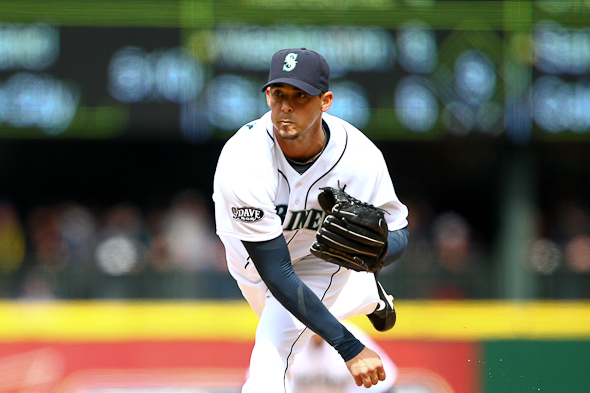
Gaps between April appearances were wide for David Pauley. He hit the hill the opening weekend, then April 10, 15 and 18.
In between, Pauley tinkered in the bullpen and on the side. Hes done so throughout his fluctuating pro career that started in 2001 in Idaho Falls. Up with the Red Sox in 2006 and 08; then back down. Back up with the Mariners for part of 2010, primarily as a starter. Off to Seattles bullpen in 2011.
He works a sinking fastball, looping curve, changeup and slider. In April, Pauley felt most of his arsenal was in order. But the changeup wasnt right. He threw a traditional four-seam circle change. The action was side to side on a level plane.
The action was lazy, so he spun the ball in his palm. Pauley worked a two-seam circle changeup. Movement was mediocre.
In the third week of April, he gave it another twist. The seams sit in his hand cockeyed now, angled off a tad. The alteration resulted in a late dip of the changeup and rise in his career.
He throws a changeup a staggering 27.5 percent of the time, according to Fangraphs.com. Thats up from 15.5 percent a year ago.
Its a contact pitch for me this year, its turned out to be more of a non-contact pitch for me, Pauley said.
The late April ratchet turn of the ball has produced a bullish ERA of 1.44. His WHIP is just 0.87. Talk has surfaced about a shot at the All-Star Game. A massive change in results developed out of the mild adjustment.
Just kind of fiddling, Pauley said of the grips genesis. Thats kind of what we do. If we find something that doesnt work we kind of mess with it until we find something that does work. I dont know anybody else who throws it that way, its kind of unconventional, but it works for me.
He showed it to starter and clubhouse neighbor Jason Vargas, even tried to help him throw a few. Vargas stuck with his, which has similar action.
Pauley possesses a deceptive repeated motion, the common key for any changeup success. But he has added elements.
His ability to mask the delivery is enhanced by that over-the-moon curveball. He often follows the curveball with a hard changeup, sometimes at 84 mph. Hitters anticipate, then read fastball following the curve, only to get the changeup.
It in a way looks like a split, but its not, Pauley said. Its got the same action as a split — down. Thats the way it has been for me this year, before you know its kind of being flat.
Pauleys fastball averages around 88 mph. Added oomph pushes it to 90. That leaves the speed differentiation between his two dominant pitches just four to six mph.
When I first started doing it I would check to see how hard it was, Pauley said. I was kind of concerned about that at first. Me and Jamey (Wright) talked about it; me and (Mariners pitching coach) Carl (Willis) talked about it. He said dont worry about the speed. Its the action that matters more than the speed.
Pauleys effectiveness allows the Mariners bullpen to survive with one left-handed specialist, Aaron Laffey. If there is a series of left-handed hitters waiting, Laffey will get the call. If two righties are followed by two lefties, that wont give manager Eric Wedge pause to call on Pauley. Left-handers are hitting just .151 against Pauley. Right-handers .216.
The left-right really goes out the door with David this year because of how hes handled them, Willis said. That changeups been a big part of that.
Pauleys numbers are so minute, the All-Star speculation has arisen. Its a longshot for any set-up man to make the team, thanks to the inane rule that forces a player from each club to be represented. Though, White Sox reliever Matt Thornton made the American League team last season for just that reason.
Pauley has been more effective than Thornton was then, minus the swollen strikeout total. But considering Felix Hernandez is likely in, Michael Pineda could be in and Ichiro could be wrongly voted in, Pauleys chance is limited at best.
He doesnt sound concerned. Hes flattered by the thought, would love to go. At the moment, hes dealing with more pressing things.
As a middle reliever, as all of us down in the bullpen, our job is not to get recognition, Pauley said. Our job is to help (the starters) get recognition and wins.
Hes getting it anyway. It took a simple twist to earn it.
